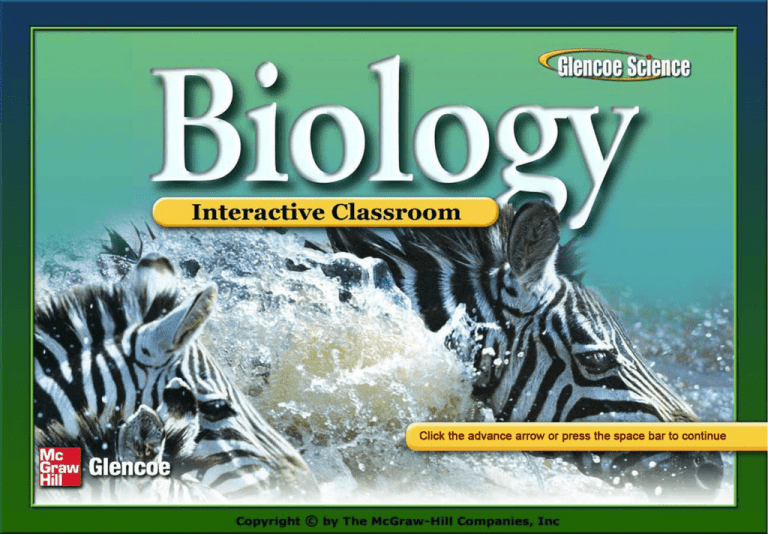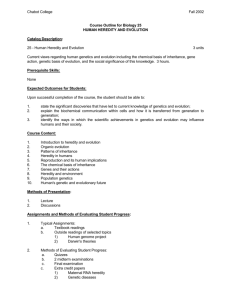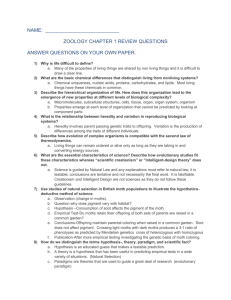Chapter 11 Complex Inheritance and Human Heredity
advertisement

Chapter 11 Complex Inheritance and Human Heredity Section 1: Basic Patterns of Human Inheritance Section 2: Complex Patterns of Inheritance Section 3: Chromosomes and Human Heredity AHSGE CONTENT STANDARD #7: Apply Mendel’s laws to determine phenotypic and genotypic probabilities of offspring. Click on a lesson name to select. Basic Patterns of Human Inheritance (Section 11.1) MAIN IDEA: The inheritance of a trait over several generations can be shown in a pedigree. 11.1 Basic Patterns of Human Inheritance Objectives • Analyze genetic patterns to determine dominant or recessive inheritance patterns. • Summarize examples of dominant and recessive disorders. • Construct human pedigrees from genetic information. Click on a lesson name to select. Review Vocabulary genes – segments of DNA that control the production of proteins. dominant – Mendel’s name for a specific trait that appeared in the F1 generation. (Webster’s: commanding, controlling, or prevailing over all others) recessive – Mendel’s name for a specific trait hidden or masked in the F1 generation. Click on a lesson name to select. New Vocabulary carrier pedigree Click on a lesson name to select. Chapter 11 Complex Inheritance and Human Heredity 11.1 Basic Patterns of Human Inheritance Recessive Genetic Disorders A recessive trait is expressed when the individual is homozygous recessive for the trait. Chapter 11 Complex Inheritance and Human Heredity 11.1 Basic Patterns of Human Inheritance Cystic Fibrosis Affects the mucus-producing glands, digestive enzymes, and sweat glands Chloride ions are not absorbed into the cells of a person with cystic fibrosis but are excreted in the sweat. Without sufficient chloride ions in the cells, a thick mucus is secreted. Cystic Fibrosis (recessive genetic disorder) Cystic Fibrosis (recessive genetic disorder) Approximately 1 in 20 people are carriers of the Cystic Fibrosis gene and when two carriers parent a child there is a 1 in 4 chance of the child being born with Cystic Fibrosis. Chapter 11 Complex Inheritance and Human Heredity 11.1 Basic Patterns of Human Inheritance Albinism Caused by altered genes, resulting in the absence of the skin pigment melanin in hair and eyes White hair Very pale skin Pink pupils Albinism (recessive genetic disorder) Chapter 11 Complex Inheritance and Human Heredity 11.1 Basic Patterns of Human Inheritance Tay-Sachs Disease Caused by the absence of the enzymes responsible for breaking down fatty acids called gangliosides Gangliosides accumulate in the brain, inflating brain nerve cells and causing mental deterioration. Tay-Sachs Disease (recessive genetic disorder) Affects 1 in 2500 people in the United States. (affects people of Jewish descent) Tay-Sachs Disease (recessive genetic disorder) Tay-Sachs Disease is often identified by a cherry-red spot on the back of the eye. Chapter 11 Complex Inheritance and Human Heredity 11.1 Basic Patterns of Human Inheritance Galactosemia Recessive genetic disorder characterized by the inability of the body to digest galactose. Galactosemia (recessive genetic disorder) Chapter 11 Complex Inheritance and Human Heredity 11.1 Basic Patterns of Human Inheritance Dominant Genetic Disorders Huntington’s disease affects the nervous system. Achondroplasia is a genetic condition that causes small body size and limbs that are comparatively short. Achondroplasia (DOMINANT genetic disorder) How is achondroplasia inherited? People with achondroplasia may pass on the condition to their children. If one parent is affected, each child has a onein-two chance of having achondroplasia, and a one-intwo chance of being average height. Those born with achondroplasia may pass the condition on to their own children, while those of average height will not. Chapter 11 Complex Inheritance and Human Heredity 11.1 Basic Patterns of Human Inheritance Chapter 11 Complex Inheritance and Human Heredity Chapter 11 Complex Inheritance and Human Heredity 11.1 Basic Patterns of Human Inheritance Pedigrees A diagram that traces the inheritance of a particular trait through several generations Chapter 11 Complex Inheritance and Human Heredity 11.1 Basic Patterns of Human Inheritance Inferring Genotypes Knowing physical traits can determine what genes an individual is most likely to have. Predicting Disorders Record keeping helps scientists use pedigree analysis to study inheritance patterns, determine phenotypes, and ascertain genotypes. Section 11.1 Summary • Genetic disorders can be caused by dominant or recessive alleles. • Cystic fibrosis is a genetic disorder that affects mucus and sweat secretions. • Individuals with albinism do not have melanin in their skin, hair, and eyes. • Huntington’s disease affects the nervous system. • Achondroplasia sometimes is called dwarfism. • Pedigrees are used to study human inheritance patterns. Complex Patterns of Inheritance (Section 11.2) MAIN IDEA: Complex inheritance of traits does not follow inheritance patterns described by Mendel. Complex Patterns of Inheritance (Section 11.2) Objectives • Distinguish between various complex inheritance patterns. • Analyze sex-linked and sex-limited inheritance patterns. • Explain how the environment can influence the phenotype of an organism. Review Vocabulary gamete – a mature sex cell (sperm or egg) with haploid number of chromosomes. New Vocabulary incomplete dominance codominance multiple alleles epistasis sex chromosome autosome sex-linked trait polygenic trait Chapter 11 Complex Inheritance and Human Heredity 11.2 Complex Patterns of Inheritance Incomplete Dominance The heterozygous phenotype is an intermediate phenotype between the two homozygous phenotypes. Chapter 11 Complex Inheritance and Human Heredity 11.2 Complex Patterns of Inheritance Incomplete Dominance …from a different perspective Codominance Both alleles are expressed in the heterozygous condition. Chapter 11 Complex Inheritance and Human Heredity 11.2 Complex Patterns of Inheritance Sickle-cell Disease Normal red blood cell Changes in hemoglobin cause red blood cells to change to a sickle shape. People who are heterozygous for the trait have both normal and sickle-shaped cells. Sickle cell 7766x Chapter 11 Complex Inheritance and Human Heredity 11.2 Complex Patterns of Inheritance Multiple Alleles Blood groups in humans ABO blood groups have three forms of alleles. Chapter 11 Complex Inheritance and Human Heredity 11.2 Complex Patterns of Inheritance Coat Color of Rabbits Multiple alleles can demonstrate a hierarchy of dominance. In rabbits, four alleles code for coat color: C, cch, ch, and c. Chapter 11 Complex Inheritance and Human Heredity 11.2 Complex Patterns of Inheritance Coat Color of Rabbits Chinchilla Albino Light gray Dark gray Himalayan Chapter 11 Complex Inheritance and Human Heredity 11.2 Complex Patterns of Inheritance Epistasis Variety is the result of one allele hiding the effects of another allele. eebb eeB_ No dark pigment present in fur E_bb E_B_ Dark pigment present in fur Chapter 11 Complex Inheritance and Human Heredity 11.2 Complex Patterns of Inheritance Sex Determination Sex chromosomes determine an individual’s gender. Chapter 11 Complex Inheritance and Human Heredity 11.2 Complex Patterns of Inheritance Dosage Compensation The X chromosome carries a variety of genes that are necessary for the development of both females and males. The Y chromosome mainly has genes that relate to the development of male characteristics. Chromosome inactivation Barr bodies Chapter 11 Complex Inheritance and Human Heredity 11.2 Complex Patterns of Inheritance Sex-Linked Traits Genes located on the X chromosome Red-green color blindness Hemophilia Sex-Linked Traits Chapter 11 Complex Inheritance and Human Heredity 11.2 Complex Patterns of Inheritance Polygenic Traits Polygenic traits arise from the interaction of multiple pairs of genes. Chapter 11 Complex Inheritance and Human Heredity 11.2 Complex Patterns of Inheritance Environmental Influences Environmental factors Diet and exercise Sunlight and water Temperature Chapter 11 Complex Inheritance and Human Heredity 11.2 Complex Patterns of Inheritance Twin Studies Helps scientists separate genetic contributions from environmental contributions Traits that appear frequently in identical twins are at least partially controlled by heredity. Traits expressed differently in identical twins are strongly influenced by environment. Section 11.2 Summary • Some traits are inherited through complex inheritance patterns, such as incomplete dominance, codominance, and multiple alleles. • Gender is determined by X and Y chromosomes. Some traits are linked to the X chromosome. • Polygenic traits involve more than one pair of alleles. • Both genes and environment influence an organism’s phenotype. • Studies of inheritance patterns of large families and twins give insight into complex human inheritance. Chromosomes and Human Heredity (Section 11.3) MAIN IDEA: Chromosomes can be studied using karyotypes. Chromosomes and Human Heredity (Section 11.3) Objectives • Distinguish normal karyotypes from those with abnormal numbers. • Define and describe the role of telomeres. • Relate the effect of nondisjunction to Down syndrome and other abnormal chromosome numbers. • Assess the benefits and risks of diagnostic fetal testing. Review Vocabulary mitosis – a process in the nucleus of a dividing cell, including prophase, metaphase, anaphase, and telophase (PMAT!!!). Click on a lesson name to select. New Vocabulary karyotype telomere nondisjunction Click on a lesson name to select. Chapter 11 Complex Inheritance and Human Heredity 11.3 Chromosomes and Human Heredity Karyotype Studies Karyotype—micrograph in which the pairs of homologous chromosomes are arranged in decreasing size. Images of chromosomes stained during metaphase Chromosomes are arranged in decreasing size to produce a micrograph. Chapter 11 Complex Inheritance and Human Heredity 11.3 Chromosomes and Human Heredity Telomeres Telomere caps consist of DNA associated with proteins. Serves a protective function for the structure of the chromosome. Chapter 11 Complex Inheritance and Human Heredity 11.3 Chromosomes and Human Heredity Nondisjunction cell division during which sister chromatids fail to separate properly Visualizing Nondisjunction Down syndrome Chapter 11 Complex Inheritance and Human Heredity Section 11.3 Summary • Karyotypes are micrographs of chromosomes. • Chromosomes terminate in a cap called a telomere. • Nondisjunction results in gametes with an abnormal number of chromosomes. • Down syndrome is a result of nondisjunction. • Tests for assessing the possibility of genetic and chromosomal disorders are available. Chapter 11 Complex Inheritance and Human Heredity Chapter Resource Menu Chapter Diagnostic Questions Formative Test Questions Chapter Assessment Questions Standardized Test Practice biologygmh.com Glencoe Biology Transparencies Image Bank Vocabulary Animation Click on a hyperlink to view the corresponding lesson. Chapter 11 Complex Inheritance and Human Heredity Chapter Diagnostic Questions Identify the disease characterized by the absence of melanin. A. albinism B. cystic fibrosis C. galactosemia D. Tay-Sachs Chapter 11 Complex Inheritance and Human Heredity Chapter Diagnostic Questions An individual with Tay-Sachs disease would be identified by which symptom? A. excessive mucus production B. an enlarged liver C. a cherry-red spot on the back of the eye D. vision problems Chapter 11 Complex Inheritance and Human Heredity Chapter Diagnostic Questions Under what circumstances will a recessive trait be expressed? A. A recessive allele is passed on by both parents. B. One parent passes on the recessive allele. C. The individual is heterozygous for the trait. D. There is a mutation in the dominant gene. Chapter 11 Complex Inheritance and Human Heredity 11.1 Formative Questions Which of Dr. Garrod’s observations about alkaptonuria was most critical to his determination that it is a genetic disorder? A. It appears at birth and runs in families. B. It is linked to an enzyme deficiency. C. It continues throughout a patient’s life, affecting bones and joints. D. It is caused by acid excretion and results in black urine. Chapter 11 Complex Inheritance and Human Heredity 11.1 Formative Questions Which is the genotype of a person who is a carrier for a recessive genetic disorder? A. DD B. Dd C. dd D. dE Chapter 11 Complex Inheritance and Human Heredity 11.1 Formative Questions Albinism is a recessive condition. If an albino squirrel is born to parents that both have normal fur color, what can you conclude about the genotype of the parents? A. at least one parent is a carrier B. both parents are carriers C. both parents are homozygous recessive D. at least one parent is homozygous dominant Chapter 11 Complex Inheritance and Human Heredity 11.2 Formative Questions When a homozygous male animal with black fur is crossed with a homozygous female with white fur, they have offspring with gray fur. What type of inheritance does this represent? A. dosage compensation B. incomplete dominance C. multiple alleles D. sex-linked Chapter 11 Complex Inheritance and Human Heredity 11.2 Formative Questions Of the 23 pairs of chromosomes in human cells, one pair is the _______. A. autosomes B. Barr bodies C. monosomes D. sex chromosomes Chapter 11 Complex Inheritance and Human Heredity 11.2 Formative Questions Which is an example of a polygenic trait? A. blood type B. color blindness C. hemophilia D. skin color Chapter 11 Complex Inheritance and Human Heredity 11.3 Formative Questions What does a karyotype show? A. The blood type of an individual. B. The locations of genes on a chromosome. C. The cell’s chromosomes arranged in order. D. The phenotype of individuals in a pedigree. Chapter 11 Complex Inheritance and Human Heredity 11.3 Formative Questions What is occurring in this diagram? A. multiple alleles B. nondisjunction C. nonsynapsis D. trisomy Chapter 11 Complex Inheritance and Human Heredity 11.3 Formative Questions What condition occurs when a person’s cells have an extra copy of chromosome 21? A. Down syndrome B. Klinefelter’s syndrome C. Tay-Sachs syndrome D. Turner’s syndrome Chapter 11 Complex Inheritance and Human Heredity Chapter Assessment Questions Use the figure to describe what the top horizontal line between numbers 1 and 2 indicates. A. 1 and 2 are siblings B. 1 and 2 are parents C. 1 and 2 are offspring D. 1 and 2 are carriers Chapter 11 Complex Inheritance and Human Heredity Chapter Assessment Questions Which is not an allele in the ABO blood group? A. IA B. IO C. IB D. i Chapter 11 Complex Inheritance and Human Heredity Chapter Assessment Questions Down Syndrome results from what change in chromosomes? A. one less chromosome on pair 12 B. one extra chromosome on pair 21 C. one less chromosome on pair 21 D. one extra chromosome on pair 12 Chapter 11 Complex Inheritance and Human Heredity Standardized Test Practice If a genetic disorder is caused by a dominant allele, what is the genotype of those who do not have the disorder? A. heterozygous B. homozygous dominant C. homozygous recessive Chapter 11 Complex Inheritance and Human Heredity Standardized Test Practice Analyze this pedigree showing the inheritance of a dominant genetic disorder. Which would be the genotype of the first generation father? A. RR B. Rr C. rr Chapter 11 Complex Inheritance and Human Heredity Standardized Test Practice Shorthorn cattle have an allele for both red and white hair. When a red-haired cow is crossed with a white-haired bull, their calf has both red and white hairs scattered over its body. What type of inheritance does this represent? A. codominance B. dosage compensation C. epistasis D. sex-linked Chapter 11 Complex Inheritance and Human Heredity Standardized Test Practice Why are males affected by recessive sexlinked traits more often than are females? A. Males have only one X chromosome. B. Males have two X chromosomes. C. Males have only one Y chromosome. D. The traits are located on the Y chromosomes. Chapter 11 Complex Inheritance and Human Heredity Standardized Test Practice A carrier of hemophilia and her husband, who is unaffected by the condition, are expecting a son. What is the probability that their son will have hemophilia? A. 25% B. 50% C. 75% D. 100% Chapter 11 Complex Inheritance and Human Heredity Glencoe Biology Transparencies Chapter 11 Complex Inheritance and Human Heredity Image Bank Chapter 11 Complex Inheritance and Human Heredity Vocabulary Section 1 carrier pedigree Chapter 11 Complex Inheritance and Human Heredity Vocabulary Section 2 incomplete dominance codominance multiple alleles epistasis sex chromosome autosome sex-linked trait polygenic trait Chapter 11 Complex Inheritance and Human Heredity Vocabulary Section 3 karyotype telomere nondisjunction Chapter 11 Complex Inheritance and Human Heredity Animation Visualizing Nondisjunction


![[11.1,11.2,11.3] COMPLEX INHERITANCE and HUMAN HEREDITY](http://s3.studylib.net/store/data/006715925_1-acaa49140d3a16b1dba9cf6c1a80e789-300x300.png)




